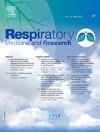Constraints to the initiation of home non-invasive ventilation and short-term efficacy in different diagnostic groups (as a prelude to an ambulatory shift)
IF 1.8
4区 医学
Q3 RESPIRATORY SYSTEM
引用次数: 0
Abstract
Introduction
Non-invasive ventilation (NIV) is the reference treatment for chronic respiratory failure (CRF) due to impairment of the ventilatory system. Home initiation is increasingly practiced. To better support this ambulatory shift, we aimed to assess the implementation constraints and short-term efficacy according to different aetiologies of CRF.
Methods
This retrospective study with cross-sectional and longitudinal analysis included patients initiated with NIV at Angers University Hospital. Patients were separated according to the following aetiologies: obesity hypoventilation syndrome (OHS), chronic obstruction pulmonary disease (COPD), amyotrophic lateral sclerosis (ALS), myopathy and chest wall disease. Implementation constraints were assessed by analysing the variability of NIV settings, the number of masks tried and the duration of hospitalisation. NIV effectiveness was assessed by measuring residual PaCO2 (arterial pressure in CO2), apnoea hypopnea index (AHIflow) and tidal volume (VT) (as displayed by the NIV software).
Results
Between October 2020 and May 2022, 102 patients were started with NIV, including a majority of ALS patients. We found a moderate variability in NIV settings (pressure, slope, triggers, etc.) within the different etiological groups, particularly in ALS. On the other hand, ALS patients required more interface trials than other groups and often had unmet efficacy criteria at hospital discharge. Interestingly, longitudinal follow-up showed a progressive improvement in efficacy criteria, particularly in patients who were initially inadequately ventilated.
Conclusion
Each aetiological group has specific constraints in the initiation of NIV that should be considered when initiating NIV in the outpatient setting.
不同诊断组对家庭无创通气启动的限制和短期疗效(作为门诊转移的前奏)。
简介:无创通气(NIV)是治疗因通气系统损伤引起的慢性呼吸衰竭(CRF)的参考治疗方法。在家入会越来越多。为了更好地支持这种动态转变,我们旨在根据不同的CRF病因评估实施限制和短期疗效。方法:采用横断面和纵向分析的回顾性研究纳入了在昂热大学医院开始的NIV患者。根据以下病因将患者分开:肥胖低通气综合征(OHS)、慢性阻塞性肺疾病(COPD)、肌萎缩侧索硬化症(ALS)、肌病和胸壁疾病。通过分析NIV设置的可变性、尝试的口罩数量和住院时间来评估实施限制。通过测量剩余PaCO2 (CO2中的动脉压)、呼吸暂停低通气指数(AHIflow)和潮气量(VT)(由NIV软件显示)来评估NIV的有效性。结果:在2020年10月至2022年5月期间,102例患者开始使用NIV,其中大多数为ALS患者。我们发现,在不同的病因组中,特别是在ALS中,NIV设置(压力、坡度、触发因素等)存在中度差异。另一方面,ALS患者比其他组需要更多的界面试验,并且在出院时往往没有达到疗效标准。有趣的是,纵向随访显示疗效标准的逐步改善,特别是在最初通气不充分的患者中。结论:每个病因组在启动NIV时都有特定的限制,在门诊启动NIV时应考虑这些限制。
本文章由计算机程序翻译,如有差异,请以英文原文为准。
求助全文
约1分钟内获得全文
求助全文
来源期刊

Respiratory Medicine and Research
RESPIRATORY SYSTEM-
CiteScore
2.70
自引率
0.00%
发文量
82
审稿时长
50 days
 求助内容:
求助内容: 应助结果提醒方式:
应助结果提醒方式:


